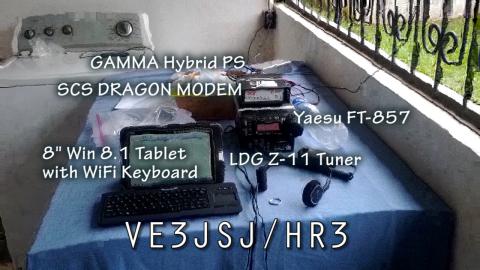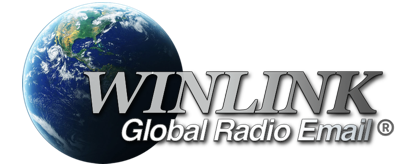VE3JSJ/HR3 -- PACTOR in the Service of Humanity

By Gordon Murray, VE3JSJ
For most of my life, two of my interests have been back-country canoeing and camping, and Amateur Radio. I often combined these two activities, carrying QRP radios on canoe trips. Starting off with the Heathkit HW 8, then the Argonaut 509, followed by the SCG2020, and now the Yaesu FT-817ND (or Elecraft KX3 if weight is not too important). The last three years I have added PACTOR capabiity--without too much weight penalty using a small 8” Win8 Tablet, and an end-fed resonant antenna covering 40m, 20m & 10m. No need for an antenna tuner.
These forays into the back country with lightweight radio gear gave me valuable experience that has served me well in situations requiring emergency/portable communications. My first experience with overseas emergency work was in 1988, when I flew to Jamaica to set up radio communications after the devastation wrought by Hurrican Gilbert. This was written up in “The Canadian Amateur”, December 1988.
So it was with great interest that I saw a posting by KB0UUP (John Kirkoff) on a Yahoo Newsgroup asking for volunteers with PACTOR capability to provide communications during a medical mission sponsored by IHS (International Health Service, www.ihsmn.org) in February this year. IHS has been doing these missions deploying 8-12 teams--about 100-120 doctors, nurses, pharmacists, dentists, engineers/hams, and general helpers across Honduras for over 30 years. IHS is well-organised and efficient. After many informative phone calls and emails with John, completion of the various documents required, and payment of the fees, I booked my flights and set off for Honduras.
I was assigned to a Hospital team in Tocoa. My station was set up in a porch of the maternity wing, which had been taken over for two weeks by the IHS “Eye Team” who were assigning eye glasses to local patients. Their prescriptions were measured by two IHS volunteers using two autorefractors connected to laptops which printed a list of appropriate glasses from the 2,000 or so pairs we had catalogued in the clinic. In addition to my communication duties, I maintained the autorefractors' computer system. A dead USB port did not help, but fortunately I had a spare mini-USB hub in my gear.
We planned regularly scheduled SSB nets between nine sites across Honduras, but local propagation was so poor we could not hear each other. Fortunately, Tom Whiteside, N5TW, in Texas had dedicated a beam antenna and special PACTOR frequencies for our use. Connecting to his Winlink gateway station was almost always on the first try. I routinely established contact using 5 watts or less.
While my location in Tocoa had spotty cell phone coverage, most other sites had no communications infrastructure at all. Winlink was it! I had a small ink-jet printer to print the sometimes critical or complex medical information emailed from remote sites, asking if some of their patients could be treated by the IHS surgical team next door to me. Useful to doctors were photographs sometimes transmitted along with the PACTOR emails. Some of the remote sites in 'La Moskitia" plains and jungles had no road access. Those teams traveled by dugout boat, or by light airplane landing on the main street of the village – after first buzzing the street to clear off donkeys, pigs, hens, dogs and cows.
I was fortunate to have had access to 120v power. All my equipment used 12v, including the ink-jet printer and tablet. I used a Yaesu 857ND, LDG Z11Pro II autotuner, and Win8 Tablet. My PACTOR modem was the SCS Dragon 7400. My power supply was the extremely light GAMMA-HYBRID (http://www.gammaresearch.net/) miniature unit, backed up with a 10AH LiPO4 battery and charger. I used a “One Banana Tree” antenna - an end-fed ZEPP from Chameleon (www.chameleonantenna.com). The feed point was about 2m off the ground, and after 25m the wire rose to 4m (Banana tree style!). No doubt this worked mainly in NVIS mode, but I did establish contacts with HF Gateways VE1YZ (Neil) in Halifax, Nova Scotia, and with VA3LKI (Michael) in Port McNicoll, Ontario, on both 20m and 40m bands.
In case of failure I took along duplicates of all my radios and computer equipment. Fortunately everything worked perfectly and I was able to set up a second PACTOR station at my overnight location.
After the mission, I spent a couple of days in Copan viewing the ancient Mayan ruins, and admiring the magnificent macaws at the superb “Macaw Mountain Bird Sanctuary”. I had the delight of lunching with the sanctuary Director, Mr. Lloyd, and enjoyed my after-service side trip immensely.
If you would like more information, here is a link to a presentation I gave recently to the Hamilton Amateur Radio Club:
https://mega.co.nz/#!V0oFhZgD!c0atV8VfgXWZ_MbHRzwOZebCpGd7jyixbSdfUuzwZ8w
And here is a link to a short video. I used my “smart-phone” so the video is not “super” HD quality”:
http://youtu.be/Yqvdl4Un1Qc
Winlink
These activities would not have been possible without the Winlink Global Radio Email system, which made email communication between Honduras and the USA/Canada so straightforward. WINLINK is run entirely by volunteers under the umbrella of the Amateur Radio Safety Foundation, Inc., and deserves our thanks and continued support: http://www.arsfi.org
N5TW
The support given by N5TW in dedicating frequencies and antennas to our use during the mission in Honduras was invaluable. Thanks to Tom Whiteside.
International Health Service
This endeavor was with International Health Service (www.ihsmn.org) who organize the medical teams, the ham support for each of them, and the incredible logistics needed to support such missions twice each year. In all, about 10 hams go every February and 1 or 2 every October so there is always a need for help. Any ham who wants to join this mission is welcome. Note that some sites use a more modest setup due to their needs for basic comm. IHS can help as they have some gear to equip each station. They also hold excellent Winlink on-air operations training weeks prior to departure. To get involved, contact the IHS Communications Director, John Kirckof, KB0UUP at [email protected] Ph 320-634-4386. He can talk with you plus send plenty of information about what these trips involve. You may also contact me - Gordon Murray Ph 905 575 3647 ([email protected])
-----------
Gordon Murray emigrated from Dublin, Ireland to Canada in 1972. He earned his amateur radio license and callsign (VE3JSJ) in 1979. He also holds the call G4RDG. His PhD is in Genetics, and his career has been in Medical Research. He lives with his wife Linda in Hamilton, Ontario, Canada, and their son Kevin (VE3CNV) is graduate student in electrical/computer engineering at the University of Toronto.
